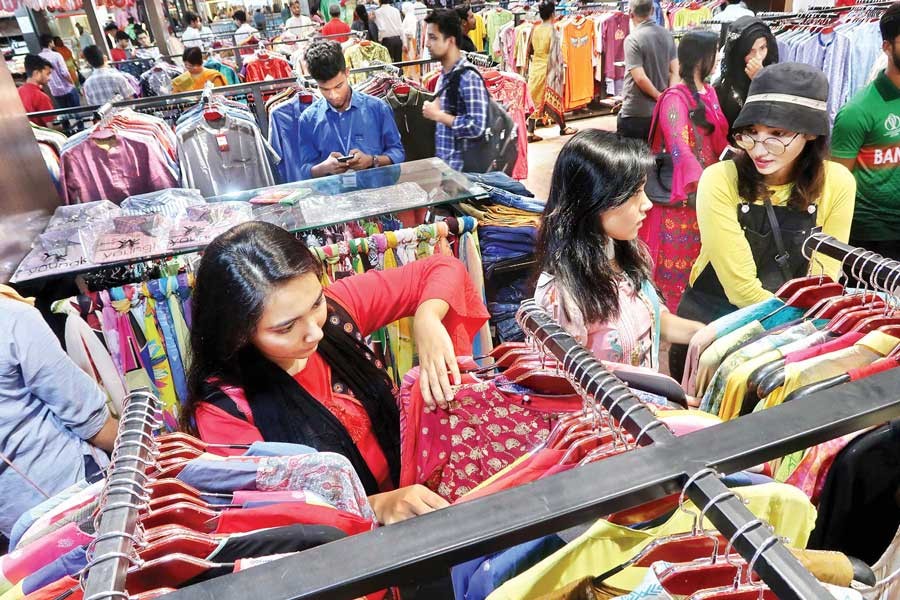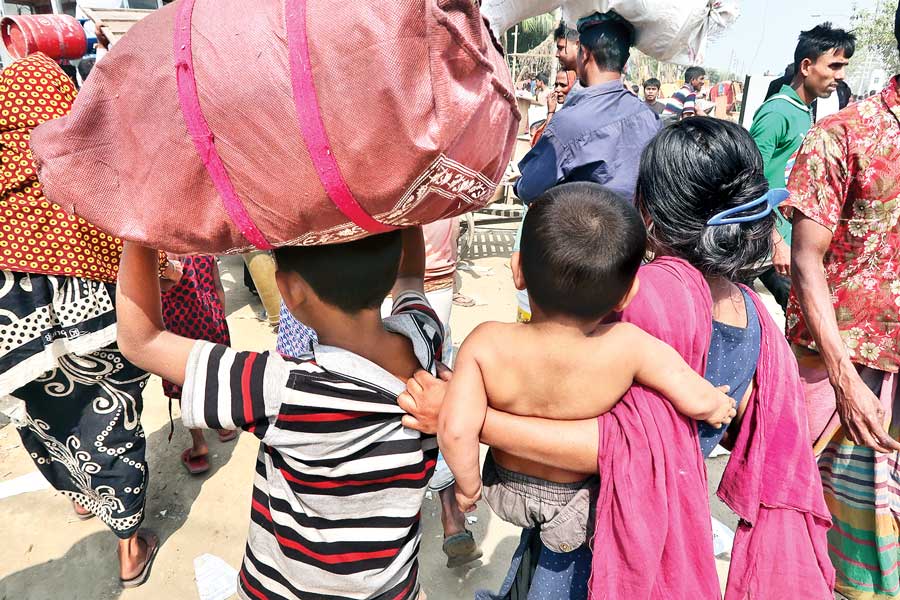 Incremental income fuels consumers' diversification across the country — FE Photo
Incremental income fuels consumers' diversification across the country — FE Photo  Diversification takes on a whole new meaning based on the type of industrial revolution in transition. Moving from textiles to steel, that is, diversifying from the First Industrial Revolution (IR 1.0) to the Second (IR 2.0), would be quite different than shifting from the Second to the Third IR (IR 3.0), based on the computer, perhaps less so from 3.0 to IR 4.0, driven by artificial intelligence (AI).
Diversification takes on a whole new meaning based on the type of industrial revolution in transition. Moving from textiles to steel, that is, diversifying from the First Industrial Revolution (IR 1.0) to the Second (IR 2.0), would be quite different than shifting from the Second to the Third IR (IR 3.0), based on the computer, perhaps less so from 3.0 to IR 4.0, driven by artificial intelligence (AI).
For Bangladesh it has to be all of the above simultaneously, that is, springing in every direction, from IR 1.0 to 2.0 to 3.0 to 4.0, since all four now have footprints here, but most importantly, we do not have time to waste: turning into a developed country inside two-decades or so demands our IR 1.0 buttress the upward shifts, but IR 2.0, IR 3.0, and IR 4.0 must reach high-gear rapidly in consonance with society, if disruptions are to be minimised.
Social consequences would reflect all the admixtures in the above discussions, but haste could haunt the transitions. The results could include an incomplete social transformation, and spiraling costs if the key arenas are to show consummation and their own trademarks. Accordingly, it might be helpful to break those social consequences into discussion compartments: gender and the family; education; social services; and environment, just to portray what future challenges economic diversification may spawn.
Gender and family is taken first since this was one of the key areas of change during our own textile revolution. Women were not only mobilised to join the work-force a generation ago, thus not only helping with the extra income, but also lowering fertility rates and childbirth. We would expect those patterns to continue, pumping up consumption, thereby adding more 'material' fat into communities, and thereby deepening the cash nexus, since cash - more than credit-cards or crypto-currency -remains the dominant Bangladesh transaction instrument. We will have no problem, against this backdrop, to climb up the middle-income ladder.
At some point we will have to blink at the population growth-rate hitting replacement levels, even beginning to dip below. That would turn blinks into lightweight concerns, but the population would be closer to the 200 million mark, a figure too high to drive us into any alarm or trend-correcting policy-shift. Two problems emerge. Though the population growth-rate is fast shrinking below the replacement level (2.0 per cent), the working-age growth rate, of 2.5 per cent, is rapidly climbing, forcing a widening gap with declining population growth-rate (United Nations Population Fund, or UNPF, The Impact of Demographic Transition on Socio-economic Development in Bangladesh: Prospects and Implications for Public Policy, Dhaka, 2015, pp. 18-9, and 54-5).

Poor people still have some reservations about family planning — FE Photo
Secondly, we must slowly return to family-planning, this time to rebuild the collapsing mid-21st century family: incentives to have more children may ultimately help us avoid the plight Japan and West European countries now face. A decade or two for such a reverse family planning approach to generate results may become years of attrition, when elderly-care would consume more out of social expenditures than now (UNPF, 134-5). Preparing pensions and other funds for such eventualities is a proposition not to be taken too lightly now, since the spiraling consumption costs (because of that materialist boom), will be biting away larger and larger chunks of our income.
Diminishing family-size, if present patterns serve as an indicator, will go hand-in-hand reflecting both nuclear and single-parent forms, as marriages will continue to reflect newer features than the traditional: they will be more flexible, transient, love-based more than arranged, and involve both partners to be in the job market, if only to make both ends meet. What might be a critical feature in the equation is the skills acquired, or training, for the job market.
We are already noticing that, among the under-4 million readymade garments (RMG) workers, the share of women keeps declining, over a generation, from 80+ per cent to just over 50 per cent, with further cuts in the wings. Part of the reason why has been the growing need for more skilled workers. Women had hitherto fared poorly with escalating skills needs, in part because of education costs, in part because the social desire of marriage inevitability made this an inefficient investment. Yet, as more females sit for secondary and higher education examinations, and a larger proportion of them perform apart from their male counterparts, seeds of change have already been sown that we should not bury under rituals and past strictures. It may still be a far cry that marriage, and with it motherhood, will not remain the ultimate whistle-blower, but balancing marriage and job-market skills-building might become the growing challenge, with childbirth paying the toll, among other spin-offs.
Since economic diversification has a tendency to produce shorter job lifespans, for example, the constantly changing Fourth Industrial Revolution technologies breeding different skills-needs almost overnight, rocking the job market constantly, the smaller future family with more disposable resources, may still become less and less stable over time: multiple skills would have to be learned, spiking costs and squeezing both family and child-rearing opportunities; and with greater social mobility and salience, male domination is unlikely to vanish, male partners abandoning wives happening more often, and perhaps showing more brazen behaviour.
Family-based dilemmas will not be far-removed from the challenges of education. Imparting skills require far more solid tertiary education infrastructures than we presently have. In the first place, the hitherto rigid management of education by the Ministry of Education's University Grants Commission would have, of necessity, to be loosened up so new training programmes can be quickly cultivated to match sudden market needs. In turn, this may change the architecture of concurrent universities: discipline-based boundaries would have to yield to job-specific training if the middle-class, particularly, is to benefit from the country's upward mobility, indeed participate in that growth hands-on.
The World Bank's Tertiary Education and Jobs Skills report, published recently, specified the actual challenges forthcoming or already unfolding: "inadequate resources for skills training access barriers for low income groups and females, absence of public funding mechanisms that incentivise production of market relevant skills; and lack of an effective regulatory and accountability framework" (p. 22). Though, it notes, the government is paying more attention to quality assurance, competency framework for technical education, skills development, teacher training and competitive R&D (research and development) funding, other glaring gaps remain: teacher performance management, intellectual property law adoption, student loan system, and funding performance-based tertiary education (pp. 30-1).
Online education might mitigate costs but also accent social gaps if not properly handled. Indeed the Sheikh Russell Digital Labs initiative to take PC (personal computer) training to primary schools across the country, as part of the Digital Bangladesh preparation, is an imperative headed in the right direction, demanding the slow creation of appropriate 3G or 4G jobs down the line. Getting that far requires public-private university collaboration, the former partner to anchor the changes (provided the above UGC rigidities have been loosened), the latter to supply part of the resources for the training big businesses will increasingly need.
Above all is the imperative to cleanse campuses of drug-addiction and classrooms of copy-pasting/plagiarism. Both 3G and 4G technologies help to capture irregularities on both fronts. Both vices have spiraled in student communities in epidemic form, making them vital social interests. Much more must also begin now to check very realistically what our university-level education needs, narrow the gaps between universities, first within the country, then against those in other countries, and ultimately acquire global-level leadership, that too, at a time when R&D resources and infrastructures are so weak in the country just when jobs increasingly require competition diffusion across national boundaries. Here too, if, for example, the paucity of libraries was, and still is, a huge problem truncating R&D indulgences, online libraries have arrived, as if for our rescue, if, and only if, we grab the opportunity, learn and disseminate the skills and knowledge available, and ultimately go into uncharted territory with them, such as innovating. That is not a quickie job; it needs preparation, especially with grooming the mindset, beginning as early as from primary schools, and constantly being monitored to produce at maximum capacity. Unless precision and professionalism become habits, no upward movement can become sustainable.
In short, without comprehensively recalibrating our current education framework and substance, Bangladesh might remain outside looking into the momentous changes taking place.
Hinted at, and related to education, is law-and-order. This involves not just rules and regulations enforcement agencies can penalise us for, but also instincts, courtesies, and procedures to navigate any roadmap, inside the class or at home, or even, and mostly, in public life outside these clusters, beginning with pedestrian-crossing rules and traffic-light obedience. For example, without a sense of order, it would be hard to master any new technology at any industrial revolution playground; the higher the technological capacities, the more likely we can be trumped by any technology for not abiding by them, as Microsoft Word is already doing with our spelling mistakes, artificial intelligence likewise, remembering which names or numbers we often contact, or if a student paper is plagiarised. Rules and regulations are needed everywhere in an online world.
Affirming them in the off-line world, for example, in the market or in stadia, may throw a larger challenge. It is possible, given the technologies available, but only if the human will is also on board to make every automobile drivers respect traffic signals in lieu of hefty, video-confirmed penalties. In fact, with jobs fluctuating, education, and family lives also in major transits, law and order will have to be up-scaled, made far more impartial, and constituted as part of every person's mindset, if economic diversification is to have safe-landing and smooth sailing.
A stable country respecting law-and-order automatically promotes a series of social services, from routine garbage collection and flood-water clearing to healthcare, childcare, elderly-care, expanding disability-friendly facilities, and so forth. The list goes on. We might already be seeing the fragments, at the least, of all of them; but since diversification is about climbing not just economic but also social staircases, these scattered, exclusive outfits have to be generalised, taken for granted, and generously disseminated for everyone. Any citizen can reach any social status if s/he has the necessary skills; and it is this break with class strictures that strengthens the need for, and availability of, a string of social services, though complicating the upward-climb. This is not to be seen as only a Bangladeshi phenomenon: it has happened in every developed country, albeit at a slower pace than the fast-lane Bangladesh finds itself in today.
The higher individuals climb socially, the more they wish to play, meaning parks and tourist spots have to not only be created, but access to them also eased. Almost all of these stem from grassroots initiatives, meaning empowering every locality to do so, particularly with disposable income guaranteed, and should also be advocated accordingly. Since our IR 1.0 began, we have become more introverted socially (before we knew our entire neighborhood; now even within our own sky-rise building, we remain strangers), and far more exclusive in our associations, for example, becoming typically unknown to the very next-door neighbour (in part, because of frequent relocations these days; and in part because we do not have time to spare for them), and so forth. Our social sense needs to be reinvigorated to make the grassroots more rewarding. Dispensing of anomie and alienation may become the pillars of economic diversification impacting society.
One final port of call is environmental sensitivity. The higher we climb the IR pole, the more we shift away from pollution-generating production, and with it, the desire for cleaner, greener, serener pastures also climbs. The water we drink, air we breathe, the theatre we visit, and the parks where we play, all enter society's demands list, climb rapidly, and without consummating the benefits of each, society and its individuals may end up on a short-shrift themselves.
Typically these begin neighbourhood-by-neighbourhood. However, as with social services, law and order and education, the government can play an enormous role to create that social network, both through initiatives and policy articulation, distribute both benefits and costs, and incentives and penalties. There is a lot to learn from two magisterial works by Robert Putnam (Bowling Alone, 2000; and Better Together, 2003). Though they address how US individualism still needs to be socially embedded, the messages and lessons are more than appropriate for all transient countries, including ours.
Ultimately, the government's role shifts from the political and security I.R. 1.0 anchors to the economic platform consolidation and dissemination under IR 2.0, then the social and environmental upgrading in IR 3.0 and IR 4.0, for the public to taste the fruits of their own diversifications. Its targets conform to these discussions; but the devil lies in the details: setting out not just the roadmap, but also crossing all "t's" and dotting all "i's."
Social entrepreneurship must arise to soften the adjustment bumps, preferably from within business domains. Corporate social responsibility imperatives may be one yardstick, with the more of them, the better that society; but it must not be the only one. Just as diversification necessitates decentralisation for more efficient outcomes, so too must social transformations shift away from state-controls and promote grassroots groups.
Here, then, is the hallmark of a successful social transformation: local groups softening both individualism associated with private industrial thrusts and unabashed state intervention. There is so much a state must do, but it is in the art of delegating state responsibilities to social outfits that informs us that economic and social diversification are happening in parallel forms. It is a rare outcome, since we human beings are not so perfect or ordered, but perhaps may remain the only safeguard from future anarchy.
Dr Imtiaz A. Hussainis is Head, Global Studies & Governance Programme at Independent University, Bangladesh.
© 2024 - All Rights with The Financial Express
